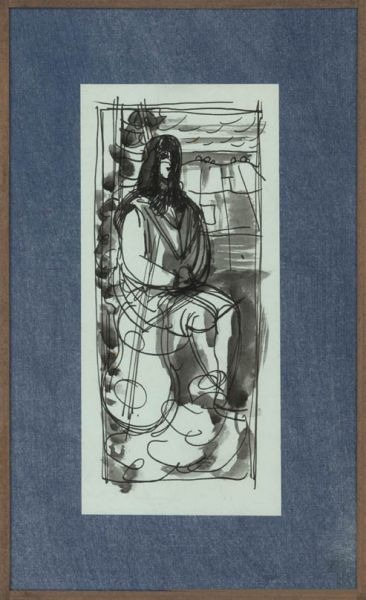
Muse with cello, circa 1950
Passe-partout (ref: 3112)
Black ink and wash on paper, 8 1/16 x 3 3/4 in. (20.5 x 9.5 cm.)
(11 7/16 x 7 in. (29 x 18 cm.) framed)

Black ink and wash on paper, 8 1/16 x 3 3/4 in. (20.5 x 9.5 cm.)
(11 7/16 x 7 in. (29 x 18 cm.) framed)
Provenance: The Artist's Studio
The Muses were a favourite theme of the artist’s. First used at Morley College, Mahoney appears to have returned to a similar theme in the late 1950s when he was asked to submit, once again, designs for Morley College which was rebuilt after its destruction in the Second World War. They represented the spiritual and creative values that the artist strove to express both in his life and work.
By the time Mahoney embarked on this last large scale work he must have known that, with his physical health failing, he was unlikely to complete it. The studies however bear testament to the remarkable clarity of vision which never surrendered to physical decline. His drawings, especially for the right hand side, are amongst the most perfect expressions of the artist working in harmony with nature. A youthful artist works undisturbed in a Garden of Eden, tended by Muses.
For drawing, Mahoney liked a textured paper, soft to the touch, such as Ingres, or still better, hand-made papers from firms such as Hayle Mill or Barcham Green. Occasionally he bought cheap sketchbooks from Woolworth’s because he found the paper so sympathetic as a surface for drawing. For his earliest drawings he used mainly B or 2B pencils, but he later preferred Black Prince or carbon pencils. He often used charcoal, adding white or red crayons to highlight drawings. Sometimes he combined these with conté crayons or pastels. For his later drawings he preferred pen and wash, taking great trouble to mix and dilute his inks until he achieved the required tone and colour. His drawing pens were either reservoir nibs in holders or else cartridge pens.